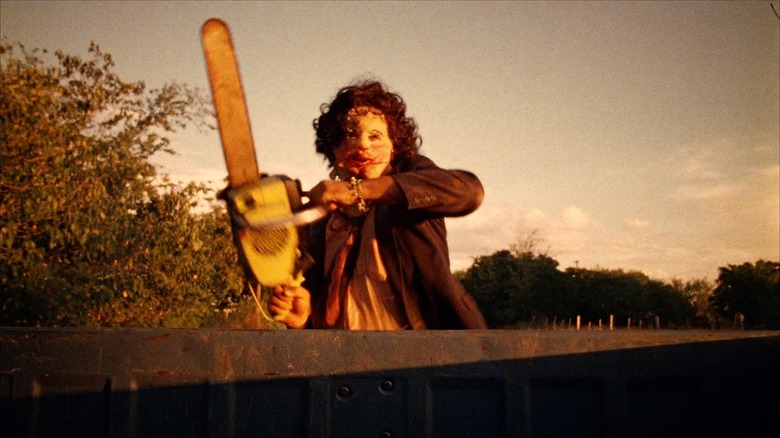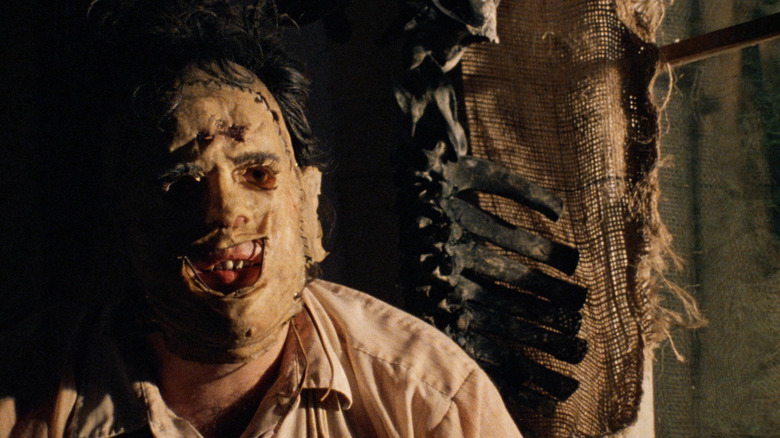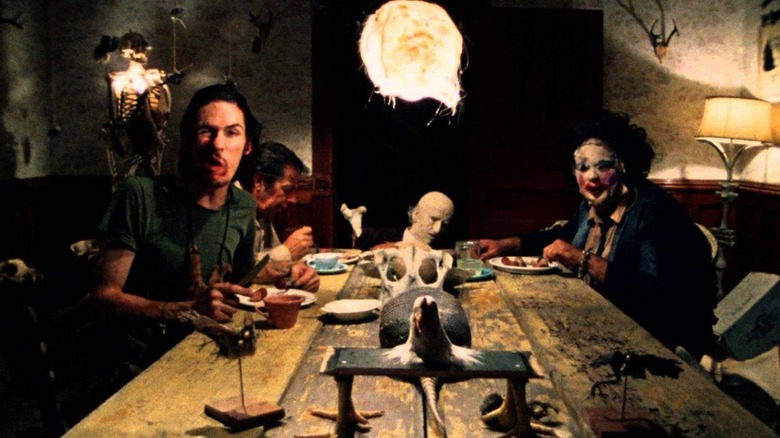Making The Texas Chain Saw Massacre Was A Nightmare
The reason director Tobe Hooper's 1974 horror film "The Texas Chain Saw Massacre" still possesses its unique terrifying power is simple: Filth. "Massacre" is a grimy, gross-looking film presented in oily browns, lard-colored yellows, and congealed reds. "Massacre" may have been photographed by cinematographer Daniel Pearl (who would also shoot the film's 2003 remake), but it looks milky, worn, tattered. It looks as if the film stock had been stored in a slaughterhouse. The visual grime of "Massacre" makes it look like its cannibal characters were the ones making it. There are moments in it where you feel like you're watching a snuff film.
It's often considered one of the best horror movies ever made.
The film's low budget made for a pretty desperate shoot. Filmed outside Round Rock, Texas, the filmmakers — in order to stay on schedule — had to insist on 16-hour work days in the middle of some pretty humid weather; the heat and sweat on screen is not faked. The 16mm cameras used on "Massacre" were NPR Eclair 16mm camerettes (the same kind used for many French New Wave films in the 1960s), which required a lot more light than traditional 35mm cameras, leading to a high grain, and stark, icky lighting that felt all too natural. The grossest budget-saving measure of all was that the filmmakers would often use real blood (not human, don't worry) to supplement the fake blood they had make. On the "Texas Chain Saw" commentary track, Hooper admits that the blood tube needed for a scene wherein actress Marilyn Burns has her finger slit wasn't working properly, so they just sliced Burns' finger open with a razor.
Gunnar Hansen played the simpleton, chainsaw-wielding brute Leatherface in "Massacre," so named because of his mask made of human skin. Hansen hadn't acted prior to playing Leatherface, and his career after would be a long string of horror movies, usually made by filmmakers who likely hired him for his connection to one of the best horror movies of all time. In 1987, Hansen wrote an article for Yankee Magazine about his experiences on the "Chainsaw" set, and how smelly things really got.
'It was too much of a risk to get them washed'
After Hansen's death in 2015, New England Today reprinted Hansen's Yankee Magazine article from years previous, wherein he detailed just how awful things got on the set of such a grimy movie. There wasn't a lot of time, evidently, and the actors were forced to wear their unwashed costumes for days in a row. With the sweltering heat and the sometimes-not-fake blood, it made for some discomfort, and some pretty severe body odor:
"It was filmed in Texas where it gets pretty hot — and sometimes shooting sessions dragged on for more than 26 hours. Since we all had only one set of clothes for the movie, it was too much of a risk to get them washed; the colors might change. So after a few weeks of shooting, it was a little more than 'fright' that made us keep our distance from each other."
The heat also left the kitchen pretty rank; the food was not fake, and leaving it out of the fridge in sweltering heat caused it to become pungent. Hansen also recalls a dangerous moment where his mask nearly caused a fatal accident:
"Kitchen scenes were pretty tough; all that food in the Texas heat, under movie lights, drew our undivided attention as well as some flies. And peering out from underneath my leather mask was practically impossible during one scene I stumbled and fell, pitching the chain saw up over my head. I covered my head and waited. It landed next to me, still running."
Nonsense and low-budget chicanery
Hansen has no regrets, and was astonished to find the film being as successful as it was. By 1987, the film already had one sequel, and it was vaunted in horror and cult film circles. Hansen was aware of its place in the pop culture firmament, and even pointed to Rex Reed's positive review. He also admits that, despite its reputation and financial success, he still didn't see much profit from it:
"But for all the nonsense and low-budget chicanery, the film did well — Rex Reed loved it. The movie became a cult hit. Current estimates put the film's gross in these past 13 years somewhere around $50 million. It was one of the hottest-selling tapes when it was released for home video. So naturally, those of us who owned a percentage of Chainsaw's profits thought we would see some substantial folding money — but alas, my complete 'take' to this day couldn't pay for a week in Disneyland."
Hansen also admits that the effectiveness and filth of the movie seems to have stymied any abilities he may have had to bank on his popularity. Who, after all, would hire Leatherface to hawk their products? He also seems to have frightened the people in his neighborhood as well:
"I can't even cash in on my notoriety — nobody will touch me. I mean, what would I do? A commercial for McCulloch with me in my backyard grunting about all the nice lawn furniture I made with my Mini-Mac? .. Nope. I guess I should have gotten a better contract. But now it's not the money that I think about; there's a much unkinder cut. This will be my 13th Halloween in Maine, and each year I have to buy less candy. Nobody comes — maybe they saw the movie."
Hansen passed away in 2015 of pancreatic cancer, but his life is celebrated every time a new horror fan or gorehound discovers the blood, sweat, and filth of "The Texas Chain Saw Massacre" for the first time. It will never be easy to watch, and that's a glorious thing.


